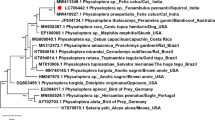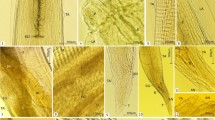Abstract
Nematodes of the genus Physaloptera are globally distributed and infect a multitude of hosts. Their life cycle involves orthopterans and coleopterans as intermediate hosts. The morphological characters alone are inadequate to detect and differentiate Physaloptera spp. from its congeners. Moreover, molecular studies are limited to compare them precisely. The present communication reports the first molecular phylogenetic characterization of feline Physaloptera spp. from India based on mitochondrial cytochrome c oxidase subunit 1 (COX1) and small subunit ribosomal DNA (18S rDNA). The nematodes were first isolated from the stomach of adult stray cats during necropsy examination. Based on the gross and microscopic characters, the worms were identified as P. praeputialis. Morphological identification was further confirmed through PCR targeting the barcode region of the mitochondrial cytochrome c oxidase subunit I (MT-COI) gene, using nematode-specific primers cocktail followed by species specific primers targeting partial COX1 and 18S rRNA genes. Generated sequences were submitted in NCBI GenBank (MW517846, MW410927, MW411349), and phylogenetic trees were constructed using the maximum likelihood method. When compared with other sequences of Physaloptera species across the globe, the present isolates showed 85.6–97.7% and 97.3–99% nucleotide homology based on COX1 and 18S rRNA gene, respectively. BLASTn analysis revealed a strong identity to other Physaloptera spp., and the phylogenetic tree placed all Physaloptera spp. in the same cluster. This study again indicates the usefulness of molecular techniques to substantiate the identity of species that may lack adequate descriptions and impart new insight for the potentially overlooked significance of P. praeputialis infections in felines.





Similar content being viewed by others
References
Borji H, Razmi G, Ahmadi A, Karami H, Yaghfoori S, Abedi V (2011) A survey on endoparasites and ectoparasites of stray cats from Mashhad (Iran) and association with risk factors. J Parasit Dis 35(2):202–206
Borthakur SK, Mukharjee SN (2011) Gastrointestinal helminthes in stray cats (Felis catus) from Aizawl, Mizoram, India. SE Asian J Trop Med 42(2):255
Bowman DD, Barr SC, Hendrix CM, Lindsay DS (2003) Gastrointestinal parasites of cats. In: Bowman DD (ed) Companion and exotic animal parasitology. Ithaca, New York, pp 779–791
Cantó GJ, García MP, García A, Guerrero MJ (2011) The prevalence and abundance of helminth parasites in stray dogs from the city of Queretaro in central Mexico. J Helminthol 85(3):263–269
Cawthorn RJ, Anderson RC (1976) Development of Physaloptera maxillaris (Nematoda: Physalopteroidea) in skunk (Mephitis mephitis) and the role of paratenic and other hosts in its life cycle. Can J Zool 54:313–323
Elsasser SC, Floyd R, Hebert PDN, Schulte-Hostedde AI (2009) Species identification of North American guinea worms (Nematoda: Dracunculus) with DNA barcoding. Mol Ecol Resour 9:707–712
Gill HS (1972) Incidence of gastro-intestinal helminths in cat (Felis catus) in Delhi. J Communic Dis 4:109–111
Goldberg SR, Bursey CR (2002) Gastrointestinal helminths of seven gekkonid lizard species (Sauria: Gekkonidae) from Oceania. J Nat Hist 36:2249–2264
Guerrero JHM, Solis MEP, Ramos JJZ, Alferez FR, Casio HH (2010) Report of Physaloptera praeputialis (Von Linstow) in mountain lion (Puma concolor, Linneaus, 1771). J Anim Vet Adv 9(3):601–603
Gupta S, Gupta S (2020) First report of a nematode Physaloptera praeputialis parasitizing a stray cat (Felis catus) from Hisar, Haryana. Haryana Veterinarian 59(2):287–288
Hajipour N, Imani Baran A, Yakhchali M, Banan Khojasteh SM, Sheikhzade Hesari F, Esmaeilnejad B, Arjmand J (2016) A survey study on gastrointestinal parasites of stray cats in Azarshahr (East Azerbaijan province, Iran). J Parasit Dis 40(4):1255–1260
Hayasaki M, Ohishi I, Munakata A (1982) Incidence of stomach worm, Physaloptera praeputialis von Linstow, 1889, in two cats and a dog in Tokyo, Japan. Jpn J Parasitol 31(6):499–506
Hobmaier M (1941) Extramammalian phase of Physaloptera maxillaris Molin,1860 (Nematoda). J Parasitol 27:233
Hoseini SM, Youssefi MR, Dozouri R, Mousapour A, Eshkevari SR, Omidzahir S, Rahimi MT (2014) Histopathological study of gastric lesions caused by Physaloptera clausa in the hedgehog. Comp Clin Pathol 23:157–160
Hota SR, Sahoo N, Mohanty B, Das DP, Pamia J (2018) Occurrence of Physaloptera praeputialis in a leopard rescued from Odisha, India. J Entomo Zoolog Stud 6(5):2276–2278
Kalyanasundaram A, Henry C, Brym MZ, Kendall RJ (2018) Molecular identification of Physaloptera sp. from wild northern bobwhite (Colinus virginianus) in the Rolling Plains ecoregion of Texas. Parasitol Res 117:2963–2969
Linstow OFB (1889) Helminthologisches. Arch Naturg, Berlin 54(1):235–246
Liu G, Li J, Zhu X (2017) Characterization of the complete mitochondrial genome of Setaria digitata (Nematoda: Setariidae) from China. J Helminthol 91(6):772–776
Mahali AK, Pand DN, Panda MR, Mohanty BN, Sahoo N (2010) Incidence and seasonal variation of gastro-intestinal parasitic infections in captive carnivores in Nandankanan zoological park Orissa. J Vet Parasitol 24(2):111–115
Maharana BR, Potliya S, Ganguly A, Bisla RS, Mishra C, Ganguly I (2020) First report of the isolation and phylogenetic characterization of equine Setaria digitata from India based on mitochondrial COI, 12S rDNA, and nuclear ITS2 sequence data. Parasitol Res 119:473–481
Maldonado A, Simoes RO, Luiz JS, Costa-Neto SF, Vilela RV (2019) A new species of Physaloptera (Nematoda: Spirurida) from Proechimys gardneri (Rodentia: Echimyidae) from the Amazon rainforest and molecular phylogenetic analyses of the genus. J Helminthol 94:e68
Mohamadain HS, Ammar KN (2012) Redescription of Physaloptera praeputialis von Linstow (Nematoda: Spirurida) infecting stray cats (Felis catus Linnaeus, 1758) in Qena, Egypt and overview of the genus taxonomy. J Egypt Soc Parasitol 42(3):675–690
Naem S, Asadi R (2013) Ultrastructural characterization of male and female Physaloptera (Spirurida: Physalopteridae): feline stomach worms. Parasitol Res 112(5):1983–1990
Naem S, Farshid AA, Marand VT (2006) Pathological findings on natural infection with Physaloptera praeputialis in cats. Vet Arh 76(4):315–321
Nilsson RH, Ryberg M, Kristiansson E, Abarenkov K, Larsson KH, Kõljalg U (2006) Taxonomic reliability of DNA sequences in public sequence databases: A fungal perspective. PLoS One 1:e59
Norman RJ, Beveridge I (1999) Redescriptions of the species of Physaloptera Rudolphi, 1819 (Nematoda: Spirurida) parasitic in bandicoots (Marsupialia: Perameloidea) in Australia. Syst Parasitol 43:103–121
Panti-May JA, Hernández-Betancourt SF, Rodríguez-Vivas RI, Robles MR (2015) Infection levels of intestinal helminths in two commensal rodent species from rural households in Yucatan, Mexico. J Helminthol 89:42–48
Petri LH, Ameel DJ (1950) Studies on the life cycle of Physaloptera rara Hall and Wigdor, 1918 and Physaloptera praeputialis Linstow, 1889. J Parasitol 36(6):40
Prosser SWJ, Velarde-Aguilar MG, León-Règagnon V, Hebert PDN (2013) Advancing nematode barcoding: a primer cocktail for the cytochrome c oxidase subunit I gene from vertebrate parasitic nematodes. Mol Ecol Resour 13:1108–1115
Quadros RM, Marques SMT, Moura ABD, Antonelli M (2014) First report of the nematode Physaloptera praeputialis parasitizing a Jaguarandi. Neotropical Biol Conserv 9(3):186–189
Ramos DGS, Santos ARGLO, Freitas LC, Correa SHR, Kempe GV, Morgado TO, Aguiar DM, Wolf RW, Rossi RV, Sinkoc AL, Pacheco RC (2016) Endoparasites of wild animals from three biomes in the state of MatoGrosso, Brazil. Braz J Vet Anim Sci 68(3):571–578
Rausch RL, Maser C, Hoberg EP (1983) Gastrointestinal helminths of the cougar, Felis concolor L., in northeastern Oregon. J Wildl Dis 19(1):14–19
Schmidt GD, Roberts LS (2009) Foundations of parasitology, 8th edn. McGraw Hill, New York
Scholz T, Uhlirova M, Ditrich O (2003) Helminth parasites of cats from the Vientiane province, Laos, as indicators of the occurrence of causative agents of human parasitoses. Parasite. 10:343–350
Schrader C, Schielke A, Ellerbroek L, Johne R (2012) PCR inhibitors–occurrence, properties and removal. J Appl Microbiol 113:1014–1026
Soulsby EJL (1982) Helminths, arthropods and protozoa of domesticated animals, 7th edn. The English Language Book Society and Baillere Tindall and Casselll Ltd, London, 656 pp
Tamura K, Nei M (1993) Estimation of the number of nucleotide substitutions in the control region of mitochondrial DNA in humans and chimpanzees. Mol Biol Evol 10:512–526
Tamura K, Stecher G, Peterson D, Filipski A, Kumar S (2013) MEGA6: Molecular Evolutionary Genetics Analysis version 6.0. Mol Biol Evol 30(12):2725–2729
Tang CQ, Leasi F, Obertegger U, Kieneke A, Barraclough TG, Fontaneto D (2012) The widely used small subunit 18S rDNA molecule greatly underestimates true diversity in biodiversity surveys of the meiofauna. Proc Natl Acad Sci U S A 109(40):16208–16212
Thompson JD, Gibson TJ, Plewniak F, Jeanmougin F, Higgins DG (1997) The Clustal X windows interface: flexible strategies for multiple sequence alignment aided by quality analysis tools. Nucleic Acids Res 24:4876–4882
Tiekotter KL (1981) Observations of the head and tail regions of male Physaloptera praeputialis von Linstow, 1889, and Physaloptera rara Hall and Wigdor, 1918, using scanning electron microscopy. Proc Helminthol Soc Wash 48:130–136
Torres FD, Otranto D (2014) Dogs, cats, parasites, and humans in Brazil: opening the black box. Parasit Vectors 7:22
Velikanov VP, Sharpillo VP (2002) Experimental indentification of Physaloptera praeputialis and Pterygodermatites cahirensis larvae (Nematoda, Spirurata) from paratenic hosts (in Russian). Vestnik Zoologii 6:25–29
Vilgalys R (2003) Taxonomic misidentification in public DNA databases. New Phytol 160:4–5
Widmer EA (1970) Development of third-stage Physaloptera larvae from Crotalus viridis Rafinesque, 1818 in cats with notes on pathology of the larvae in the reptile. (Nematoda, Spiruroidea). J Wildl Dis 6:89–93
Wu S, Xiong J, Yu Y (2015) Taxonomic resolutions based on 18S rRNA genes: a case study of subclass copepoda. PLoS One 10(6):e0131498
Acknowledgements
The authors express their sincere sense of gratitude to the Director of Research and Vice Chancellor, LUVAS, Hisar, for providing research facilities and financial support.
Author information
Authors and Affiliations
Corresponding author
Ethics declarations
Conflict of interest
The authors declare no competing interests.
Additional information
Section Editor: Abdul Jabbar
Publisher’s note
Springer Nature remains neutral with regard to jurisdictional claims in published maps and institutional affiliations.
Rights and permissions
About this article
Cite this article
Maharana, B.R., Gupta, S., Gupta, S. et al. First report of molecular and phylogenetic analysis of Physaloptera praeputialis in naturally infected stray cats from India. Parasitol Res 120, 2047–2056 (2021). https://doi.org/10.1007/s00436-021-07163-2
Received:
Accepted:
Published:
Issue Date:
DOI: https://doi.org/10.1007/s00436-021-07163-2




